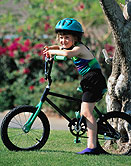Home > News
|
Kid Bicyclists Slow to Move in TrafficBy E.J. Mundell |
|

FRIDAY, July 16 (HealthDayNews) -- If you're the average bike-riding adult, your foot is already firmly positioned on the pedal, ready for forward motion, whenever you wait for a break in busy traffic.
However, a new study using virtual reality finds the average kid may be much less prepared -- and thus, less safe -- in the same situation.
The finding could have real implications in preventing the dozens of deaths and hundreds of thousands of injuries in the United States linked to child bike accidents each year.
"We think that kids and adults are perceiving the visual information -- the size of gaps in traffic -- probably fairly similarly. But the kids just aren't as ready to go as the adults are," explained lead researcher Jodie M. Plumert, a professor of psychology at the University of Iowa.
According to Plumert, this means that if cars speed up unexpectedly, or a child loses temporary control of the bike, "then the child might be in trouble, because they just don't have the same margin for error that adults have."
The study, funded by a grant from the National Science Foundation and the National Center for Injury Control and Prevention, appears in the July issue of Child Development.
Peter Moe, bicycle and pedestrian program manager for the National Safe Kids Campaign, said that while U.S. statistics are improving, the numbers of children hurt in bicycling accidents remains high.
"In terms of the scope of the problem, in 2001 there were 134 kids that died in bike-related crashes, and about 290,000 were treated in hospital emergency rooms for bike-related injuries," he said.
About 90 percent of those deaths and serious injuries involved crashes between bike-riding children and automobiles.
In her research, Plumert sought to determine whether there was anything specific to the bicycling skills of children that might make them more prone to traffic accidents. Working with Iowa computer experts Joseph Kearney and James Cremer, she constructed a three-sided virtual reality streetscape that effectively replicated real-world traffic.
"It essentially provides you with 270 degrees of visual imagery. It's as if you were looking straight down a street as it would look in front of you, with cross streets at either side," Plumert said.
In the study, the Iowa researcher observed 20 adults and 40 children aged 10 to 12 as they drove a stationary bicycle within this high-traffic virtual environment. As the cyclists came up to each intersection, they slowed down or stopped, crossing only when they detected what they believed to be an appropriate gap in traffic flow.
According to Plumert, adolescent and adult bikers tended to make their crossings during similarly sized gaps in traffic.
But even though kids chose the same gaps as adults, when Plumert timed the actual crossing, she found children left far less time to spare between themselves and the next approaching car, compared with adults.
For adults, the average time gap between the bicyclist's first entering the roadway and the next approaching car totaled about 3.3 seconds, compared to just 2.8 seconds for the average 12-year-old and 2.5 seconds for 10-year-olds.
"The bottom line," Plumert said, "is that kids are taking longer to get that bike started into the roadway."
Foot positioning prior to movement may be key, she said. "I've been watching kids recently in a new study that we're doing. Especially among the 10-year-olds, the place where they have their feet on the pedals is just not where you'd want them to be in order to get across the road."
"The pedals should be on the diagonal," she pointed out. "But the kids, often they have the pedals backwards, straight up and down, or a little bit behind."
In the vast majority of cases, kids still got safely across the virtual road even if they started a little late. "But if you were in a real-world environment and something happened -- your foot slipped off the pedal, say -- then kids might be in trouble," Plumert said.
Moe said the study "reinforces the need to continue to give our kids education about bike safety, not just as little kids but as they grow and develop."
He said the most effective step parents can take to encourage safe biking habits in their kids is to lead by example -- wear a helmet whenever cycling as a family, come to a full stop at intersections, and practice that pedal-forward stance when preparing to cross busy streets.
According to Moe, this type of parental "modeling" goes a long way to helping kids "develop good behaviors, so that they are much more likely to engage in those behaviors when they are unsupervised."
More information
To learn more about child bike safety, check out Safe Kids.
(SOURCES: Jodie M. Plumert, Ph.D., professor, psychology, University of Iowa, Iowa City; Peter Moe, manager, Bicycle and Pedestrian Program, National Safe Kids Campaign, Washington, D.C.; July 2004 Child Development)
Copyright © 2004 ScoutNews, LLC. All rights reserved.
HealthDayNews articles are derived from various sources and do not reflect federal policy. healthfinder® does not endorse opinions, products, or services that may appear in news stories. For more information on health topics in the news, visit the healthfinder® health library.